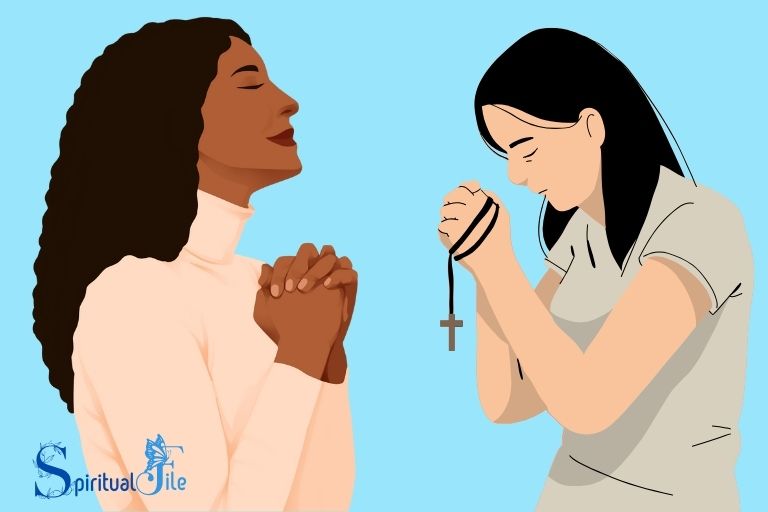Cmop-E Spirituality Examples: Occupational Therapy!
The Canadian Model of Occupational Performance and Engagement (CMOP-E) highlights the importance of spirituality in occupational therapy.
Some examples of spirituality under CMOP-E include engaging in specific religious practices, finding peace in nature or art, participating in mindful meditation, and maintaining personal values and beliefs that contribute to a sense of purpose.
The CMOP-E recognizes spirituality as a core component of a person’s identity that motivates and drives occupational engagement.
It refers to the personal quest for understanding answers to ultimate questions about life, about meaning, and about the relationship with the sacred or transcendent.
It can be expressed in various ways like through religious practices, connection with nature, or values and beliefs.
The Canadian Model of Occupational Performance and Engagement (CMOP-E) places huge emphasis on spirituality as the core of a person, around which other components revolve.
It underlines that spirituality goes beyond religious practices and includes any activity or belief that provides a sense of meaning, purpose, and connection, thereby enhancing a person’s ability to engage and perform in various occupations.
6 Examples of CMOP-E Spirituality
| Example | Explanation | Example |
|---|---|---|
| Personal Spirituality | Spirituality experienced on a personal level, without the need for organized religion. | Meditation, Yoga, Nature walks |
| Organized Religion | Spirituality as part of a communal experience through organized religious practice. | Attending church, Mosque, Synagogue, Participation in religious rituals |
| Intellectual Spirituality | Spirituality experienced through the pursuit of knowledge and intellectual activities. | Philosophy, Reading, Writing, Debating ethical issues |
| Naturalistic Spirituality | Spirituality experienced through connection with nature or the universe. | Gardening, Hiking, Observing the stars |
| Social Spirituality | Spirituality experienced through connection with other people. | Volunteering, Helping others, Providing community service |
| Creative Spirituality | Spirituality experienced through creative activities. | Painting, Music, Dance |
Key Takeaway

Five Facts About: CMOP-E Spirituality Examples
Understanding Spirituality In Occupational Therapy
Understanding spirituality in occupational therapy is exemplified through the cmop-e model. This approach recognizes spiritual well-being as an integral part of a client’s overall health and promotes its inclusion in therapy interventions.
The model highlights the importance of addressing spiritual needs to enhance holistic care and client outcomes.
Spirituality As A Holistic Aspect Of Human Experience
Spirituality encompasses more than just religious beliefs and practices. In the context of occupational therapy, spirituality is considered a fundamental aspect of holistic healthcare.
It recognizes that individuals are more than just their physical bodies and places importance on their mental, emotional, and spiritual well-being as well.
- Spirituality acknowledges the connection between mind, body, and spirit in achieving overall health and well-being.
- It focuses on finding meaning and purpose in life, personal values, and beliefs.
- Spirituality recognizes the unique experiences and cultural backgrounds of individuals, respecting their diverse paths to spiritual fulfillment.
Definition Of Spirituality In The Context Of Occupational Therapy
In occupational therapy, spirituality is defined as the inherent sense of connectedness to something greater than oneself, as well as the pursuit of meaning, purpose, and transcendence in life.
It encompasses one’s beliefs, values, and the practices that contribute to their spiritual well-being.
- Spirituality is not limited to religious practices; it includes personal philosophies, mindfulness, and connection to nature or art.
- Occupational therapists embrace spirituality as an essential component of their holistic approach to promoting health and well-being.
Role Of Spirituality In Promoting Health And Well-Being
Spirituality plays a crucial role in occupational therapy by enhancing overall health and well-being. It can positively impact individuals’ physical, mental, and emotional health, as well as their ability to engage in meaningful occupations.
- Spirituality provides individuals with a sense of purpose, meaning, and hope, which can motivate them to overcome challenges and navigate life transitions.
- It can contribute to stress reduction, emotional resilience, and improved coping strategies.
- By addressing spiritual needs, occupational therapists can help individuals develop a sense of balance, harmony, and satisfaction in their lives.
Spirituality is a holistic aspect of human experience that goes beyond religious beliefs. In occupational therapy, spirituality is recognized as a vital component of overall well-being, encompassing personal values, beliefs, and practices.
By acknowledging and addressing spirituality, occupational therapists can contribute to individuals’ physical, mental, and emotional health, supporting them in living meaningful and fulfilling lives.
Cmop-E Model: An Overview
The cmop-e model provides valuable insights into various examples of spirituality, offering a comprehensive overview for understanding its role in occupational therapy practice.
This model emphasizes the significance of personal beliefs and values in promoting well-being and recovery.
The cmop-e model is a valuable framework used in occupational therapy to understand the interconnectedness between a person’s spirituality, occupations, environment, and person.
By recognizing the importance of spirituality in an individual’s well-being, the cmop-e model promotes a holistic approach to therapy.
In this section, we will explore the components of the cmop-e model in more detail, focusing on spirituality and how it is integrated within this framework.
Components Of The Cmop-E Model: Spirituality, Occupations, Environment, And Person
The cmop-e model consists of four main components that play a crucial role in shaping an individual’s occupational performance.
Let’s take a closer look at each component:
Spirituality:
- Spirituality encompasses an individual’s beliefs, values, and sense of meaning or purpose in life.
- It provides a framework for understanding the connection between the mind, body, and spirit, and how they influence occupational performance.
- Incorporating spirituality into therapy can enhance a person’s well-being, resilience, and recovery.
Occupations:
- Occupations refer to the activities that individuals engage in on a daily basis, including self-care, work, and leisure.
- These activities contribute to a person’s identity, sense of purpose, and overall health and well-being.
- The cmop-e model recognizes the importance of meaningful occupations in promoting mental, emotional, and physical well-being.
Environment:
- The environment refers to the physical, social, and cultural surroundings in which individuals live and engage in occupations.
- The environment can either support or hinder occupational engagement and well-being.
- Occupational therapists consider how environmental factors, such as accessibility or social support, impact a person’s ability to participate in desired occupations.
Person:
- The person component takes into account an individual’s unique characteristics, including their physical, psychological, and cognitive abilities.
- Occupational therapists consider a person’s strengths, limitations, motivations, and goals when designing interventions.
- By understanding the person as a whole, therapists can tailor interventions that promote meaningful engagement in occupations.
Understanding The Integration Of Spirituality Within The Cmop-E Model
The cmop-e model recognizes the significance of spirituality as an integral part of an individual’s identity and well-being. By incorporating spirituality within this model, occupational therapists can create a more holistic approach to therapy.
Here’s how spirituality is integrated within the cmop-e model:
Informed practice:
- Occupational therapists strive to have a deep understanding of their clients’ spiritual beliefs and values.
- By incorporating these beliefs into therapy, therapists can better understand their clients’ motivations and goals, thus enhancing the therapeutic relationship.
Meaningful occupation:
- Spirituality is intertwined with an individual’s sense of meaning and purpose in life.
- Occupational therapists help clients identify meaningful occupations that align with their spiritual beliefs, promoting a sense of fulfillment and well-being.
Environment adaptation:
- The integration of spirituality within the cmop-e model encourages therapists to consider environmental factors that support or hinder spiritual practices.
- Therapists may collaborate with clients to create environments that foster spiritual growth and well-being.
Person-centered approach:
- Recognizing an individual’s spiritual identity helps occupational therapists tailor interventions that align with their clients’ values and beliefs.
- By acknowledging and incorporating spirituality, therapists can empower clients in their personal journeys of growth and healing.
The cmop-e model provides a comprehensive framework that integrates spirituality with other essential components like occupations, environment, and person.
By recognizing the significance of spirituality, occupational therapists can establish a more holistic approach to therapy that promotes well-being and empowers individuals on their unique paths to health and fulfillment.
Examples Of Spirituality In Occupational Therapy
Explore the practical application of spirituality in occupational therapy through cmop-e examples. Discover how spirituality can enhance the healing process and promote overall well-being in patients.
Cmop-E Spirituality Examples
Spirituality plays a vital role in occupational therapy, encompassing the holistic approach to promoting health and well-being.
By addressing the spiritual needs of individuals, occupational therapists can enhance their interventions, helping clients achieve a sense of purpose, meaning, and connectedness.
In this section, we will explore examples of incorporating spirituality into occupational therapy practice, addressing the spiritual needs of individuals across various settings, and examining case studies that highlight the role of spirituality in occupational therapy.
Incorporating Spiritual Practices Into Occupational Therapy Interventions:
- Spiritual assessment: Occupational therapists can assess clients’ spiritual beliefs, values, and practices to gain a better understanding of their spiritual needs.
- Mindfulness-based interventions: Utilizing mindfulness techniques can help individuals cultivate spiritual awareness, reduce stress, and promote a sense of grounding and tranquility.
- Therapeutic use of nature: Connecting individuals with nature, such as engaging in outdoor activities or incorporating nature-based elements in therapy, can foster spiritual well-being and a sense of connection to the environment.
- Meditation and prayer: Encouraging individuals to engage in meditation or prayer practices can nurture spiritual growth, self-reflection, and emotional well-being.
- Art and creativity: Engaging in artistic activities allows individuals to explore and express their spirituality, fostering self-discovery and emotional healing.
Addressing The Spiritual Needs Of Individuals Across Different Settings:
- Acute care: Occupational therapists can support patients in finding meaning and purpose amidst their medical condition, incorporating spiritual practices to address emotional distress and provide comfort.
- Mental health: When working with individuals experiencing mental health challenges, occupational therapists can facilitate the exploration of spirituality as a coping mechanism, aiding in recovery and self-empowerment.
- Geriatrics: Occupational therapists can address the spiritual needs of older adults by incorporating reminiscence therapy, life review activities, and spiritual practices to enhance overall well-being and life satisfaction.
- Palliative care: In end-of-life care, occupational therapists play a significant role in supporting patients and their families by addressing existential concerns, providing emotional support, and facilitating spiritual exploration and acceptance.
Case Studies Highlighting The Role Of Spirituality In Occupational Therapy:
Case study 1: Mary, a stroke survivor, experienced feelings of depression and loss of purpose. Through occupational therapy interventions, mary was guided in incorporating spirituality into her daily routine, engaging in meditation and finding solace in nature.
As a result, mary reported improved emotional well-being and a renewed sense of meaning in her life.
Case study 2: John, a military veteran grappling with post-traumatic stress disorder, found it challenging to connect with others and engage in meaningful activities.
Occupational therapy sessions incorporated mindfulness techniques, art therapy, and support groups focused on spirituality.
These interventions promoted a sense of connection, improved john’s mental well-being, and empowered him to redefine his life’s purpose.
Incorporating spirituality into occupational therapy practice allows therapists to holistically address the needs of individuals, promoting emotional well-being, meaning, and connectedness.
By assessing spiritual beliefs, utilizing mindfulness techniques, and fostering creativity, occupational therapists can empower clients to embark on a journey of self-discovery, healing, and personal growth.
Through the exploration of case studies, we can witness the transformative impact spirituality can have in occupational therapy settings, reinforcing the importance of this integral component in the therapeutic process.
The Role Of Mindfulness In Occupational Therapy
This article explores the role of mindfulness in occupational therapy, focusing specifically on examples of spirituality within the cmop-e framework. Discover how mindfulness practices can enhance therapeutic outcomes and promote holistic well-being.
Exploring Mindfulness As A Spiritual Practice In Occupational Therapy
Mindfulness is a powerful tool that can be seamlessly incorporated into occupational therapy sessions, enhancing the spiritual aspect of treatment.
By encouraging individuals to be fully present and non-judgmentally aware of their thoughts, feelings, and sensations, mindfulness cultivates a deeper connection to one’s self and the surrounding environment.
It allows individuals to tap into their inner resources, facilitating healing, growth, and self-discovery.
Benefits Of Incorporating Mindfulness In Therapy Sessions
Incorporating mindfulness into occupational therapy sessions provides a wide array of benefits for clients.
Here are some key advantages:
Reduction of stress and anxiety: Mindfulness helps individuals to bring their attention to the present moment, enabling them to let go of worry and stressors. By cultivating a sense of calm and relaxation, it enhances mental well-being and promotes emotional resilience.
Improved focus and attention: Mindfulness exercises train the mind to concentrate on the present moment, leading to enhanced focus and attention. This heightened mental clarity can improve performance in daily activities, work tasks, and overall cognitive functioning.
Enhanced self-awareness: Mindfulness practices facilitate self-reflection and self-awareness, helping individuals gain insights into their thoughts, emotions, and behaviors.
This increased self-awareness allows for more informed decision-making and the ability to change unhelpful patterns.
Increased body awareness: Mindfulness encourages individuals to tune into their bodily sensations, promoting a deeper understanding of the mind-body connection.
This heightened body awareness can lead to improved coordination, balance, and physical well-being.
Techniques For Integrating Mindfulness Into Occupational Therapy Interventions
Integrating mindfulness into occupational therapy interventions can be accomplished through various techniques.
Here are some effective strategies:
Guided meditation: Incorporate guided meditation exercises to help clients develop their mindfulness practice. This can involve focusing attention on the breath, body scans, or guided imagery to cultivate a sense of presence and relaxation.
Mindful movement: Utilize mindful movement exercises such as yoga, tai chi, or mindful walking to help clients embody the practice of mindfulness. These activities can promote physical well-being while simultaneously fostering a deeper sense of mindfulness.
Sensory awareness: Facilitate sensory-focused activities to heighten awareness in the present moment. Exploring different textures, scents, tastes, and sounds can help individuals ground themselves and cultivate mindfulness.
Mindful self-compassion: Encouraging clients to practice self-compassion while cultivating mindfulness can be transformative. This involves being kind, accepting, and non-judgmental toward oneself during moments of frustration or difficulty.
Integration into daily routines: Encourage clients to integrate mindfulness into their daily routines, such as eating mindfully or practicing mindfulness during routine activities like showering or brushing their teeth.
These small moments of mindfulness can have a significant impact on overall well-being.
By embracing mindfulness as a spiritual practice in occupational therapy, therapists can empower their clients to develop a deeper understanding of themselves, reduce stress, improve focus and attention, and enhance overall well-being.
Incorporating these techniques into therapy interventions can offer a truly holistic approach to treatment, fostering growth, and transformation.
Promoting Meaningful And Purposeful Occupations
Discover inspiring examples of cmop-e spirituality and how it can promote meaningful and purposeful occupations.
Explore the transformative power of incorporating spirituality into your daily life.
Understanding The Connection Between Spirituality And Occupational Engagement
- Spirituality is an integral part of many individuals’ lives and can greatly impact their well-being and overall satisfaction.
- Occupational engagement refers to the involvement in purposeful and meaningful activities that bring a sense of fulfillment and joy.
- There is a deep connection between spirituality and occupational engagement, as both contribute to a person’s sense of meaning and purpose in life.
- When individuals engage in occupations that align with their spiritual beliefs and values, it enhances their overall well-being and promotes holistic growth.
Strategies For Fostering Meaningful And Purposeful Occupations In Therapy
Therapists play a critical role in helping individuals explore and develop meaningful and purposeful occupations in the context of their spirituality.
Here are some strategies that therapists can employ to foster this connection:
Collaborative goal setting:
- Work with individuals to identify their spiritual values and goals related to their occupations.
- Incorporate their beliefs and values into the therapy process to ensure a holistic approach.
Activity analysis:
- Analyze the meaningful activities individuals engage in and identify how those activities align with their spiritual beliefs.
- Help individuals find ways to incorporate spirituality into their existing occupations or explore new activities that have a spiritual dimension.
Mindfulness and reflection:
- Encourage individuals to cultivate mindfulness and reflection practices to deepen their awareness of the spiritual aspects of their occupations.
- This can involve meditation, journaling, or engaging in self-reflection exercises.
Rituals and ceremonies:
- Explore the use of rituals and ceremonies that hold significance for individuals’ spiritual beliefs.
- Incorporate these practices into therapy sessions to promote meaning and purpose in their occupations.
Examples Of Interventions That Promote Spiritual Well-Being Through Occupations
Therapists can utilize various interventions to help individuals experience spiritual well-being through their occupations.
Some examples include:
Nature-based activities:
- Engage individuals in activities such as gardening, hiking, or nature walks to promote a connection with the natural world and enhance their spiritual well-being.
Art therapy:
- Encourage individuals to express their spirituality through creative activities like painting, drawing, or sculpting.
- This allows them to explore and manifest their beliefs and values visually.
Volunteer work:
- Engage individuals in volunteer opportunities that align with their spiritual values.
- This not only contributes to the well-being of others but also provides a sense of purpose and fulfillment.
Mind-body practices:
- Integrate mind-body practices like yoga, tai chi, or meditation to help individuals cultivate a deeper connection with their spirituality while engaging in physical activities.
Remember, promoting meaningful and purposeful occupations that incorporate spirituality is essential for individuals’ overall well-being. Therapists can play a vital role in fostering this connection and helping individuals lead more fulfilling lives.
Addressing Spirituality In Occupational Therapy Education And Training
Occupational therapy education and training now recognize the significance of addressing spirituality, as evident in the cmop-e spirituality examples.
These examples provide practical demonstrations of the incorporation of spirituality into occupational therapy practice.
Spirituality plays a crucial role in occupational therapy, as it encompasses a person’s beliefs, values, and sense of purpose, which are essential in the process of healing and well-being.
To ensure that occupational therapy education and training adequately address spirituality, the following aspects should be considered:
The Importance Of Incorporating Spirituality In Occupational Therapy Curricula
- Understanding the significance: Recognizing the impact of spirituality on the overall well-being of individuals is vital in providing holistic care.
- Enhancing client-centered care: By incorporating spirituality, occupational therapists can better understand and meet the unique needs of their clients.
- Promoting coping strategies: Addressing spirituality allows individuals to develop adaptive mechanisms to navigate life challenges and cultivate resilience.
Training Occupational Therapists To Integrate Spirituality Into Practice
- Providing theoretical knowledge: Educators should offer training on the theoretical aspects of spirituality and its relevance to occupational therapy practice.
- Developing self-awareness: Occupational therapists need opportunities to reflect on their own spiritual beliefs to foster empathy and provide non-judgmental care.
- Teaching assessment techniques: Training should include methods to assess clients’ spirituality and integrate it into the therapeutic process.
- Encouraging interdisciplinary collaboration: Collaborating with other healthcare professionals can enhance the integration of spirituality into occupational therapy practice.
Challenges And Considerations For Addressing Spirituality In Education And Training
- Cultural competence: Recognizing the diverse spiritual beliefs and practices of individuals is essential to provide culturally sensitive care.
- Ethical considerations: Educators must discuss ethical boundaries and professional limitations when addressing spirituality within therapeutic relationships.
- Lack of standardized guidelines: Establishing clear guidelines and frameworks for incorporating spirituality in occupational therapy curricula can help guide educators.
- Personal biases and beliefs: Educators should be aware of their personal biases to ensure an open and inclusive learning environment.
- Resource limitations: Limited resources on integrating spirituality into occupational therapy education can pose challenges for educators.
By addressing the importance of spirituality in occupational therapy curricula, training therapists to integrate spirituality into practice, and considering the associated challenges, education.
Training programs can empower occupational therapists to provide holistic care that incorporates the spiritual dimension of individuals’ lives.
Ethical Considerations In Addressing Spirituality In Occupational Therapy
When addressing spirituality in occupational therapy, ethical considerations should be carefully considered. Examples of incorporating spirituality within the cmop-e framework can guide therapists in providing holistic and client-centered care.
Respecting Clients’ Beliefs And Values In The Therapeutic Process:
- Occupational therapists understand the importance of respecting their clients’ spiritual beliefs and values, as it plays a significant role in their wellbeing. Treatment plans are tailored to incorporate these beliefs, ensuring a holistic approach to therapy.
- By acknowledging and considering clients’ spirituality, therapists establish trust, promote open communication, and foster a collaborative therapeutic relationship.
- Respecting clients’ beliefs involves active listening, demonstrating empathy, and refraining from imposing personal beliefs. The therapist’s role is to support and guide clients through their individual spiritual journeys, rather than influencing or contradicting their beliefs.
Navigating Sensitive Spiritual Discussions In Therapy:
- Initiating spiritual discussions can be challenging, as it requires sensitivity and an understanding of cultural and religious diversity. Occupational therapists follow ethical guidelines to navigate these discussions effectively.
- Creating a safe and non-judgmental environment sets the foundation for open dialogue about spirituality. Therapists can encourage clients to share by using open-ended questions, active listening, and demonstrating empathy.
- It is essential to respect boundaries and never impose personal beliefs during these discussions. The focus should be on exploring the client’s perspective, experiences, and understanding of spirituality in relation to their goals and overall well-being.
Maintaining Professional Boundaries While Addressing Spirituality:
Occupational therapists are trained to maintain professional boundaries throughout the therapeutic process, including when addressing spirituality. These boundaries ensure that the focus remains on the client’s needs and goals.
Therapists must be aware of their own beliefs and biases to prevent potential conflicts or the imposition of personal views. This self-awareness allows therapists to provide client-centered care without compromising their professional ethical responsibilities.
Professional boundaries establish clear roles and expectations, ensuring that the therapeutic relationship remains professional and therapeutic in nature.
The therapist’s primary objective is to support and guide clients in exploring their own spirituality, rather than providing religious or spiritual advice.
Remember, the expertise of occupational therapists lies in their ability to understand and respect the diverse spiritual beliefs and values of their clients.
By creating a safe and supportive environment, therapists can effectively address spirituality while maintaining professional boundaries.
Research And Evidence In Spirituality And Occupational Therapy
The integration of research and evidence in the field of occupational therapy highlights practical examples of spirituality using the cmop-e model.
These examples demonstrate the importance of spirituality in providing holistic care and promoting overall well-being.
Spirituality has emerged as an important aspect of occupational therapy, offering a holistic approach to client-centered care.
Through the integration of spirituality, therapists aim to address not only physical challenges but also mental, emotional, and spiritual well-being.
The following sections explore the role of research and evidence in spirituality and occupational therapy, highlighting the current state of understanding, evidence-based interventions, and areas for future research.
Reviewing Current Research On Spirituality And Occupational Therapy:
Research in spirituality and occupational therapy focuses on understanding the relationship between spirituality and client outcomes, as well as identifying effective interventions.
Key points to consider include:
- The exploration of how spirituality impacts occupational performance and overall well-being.
- Identifying the connection between spirituality and meaningful engagement in occupation.
- Investigating the influence of spirituality on the rehabilitation process and the therapeutic relationship.
Evidence-Based Interventions Incorporating Spirituality:
Occupational therapists are increasingly incorporating spirituality into their interventions.
Evidence-based approaches include:
- Guided imagery: Using visualization techniques to facilitate engagement in meaningful occupations.
- Mindfulness-based practices: Incorporating mindfulness meditation to promote self-awareness and decrease stress.
- Spiritual life review: Encouraging the exploration and reflection of one’s life story, fostering personal growth and meaning.
Gaps And Future Directions For Research In The Field:
While there is growing interest in spirituality and occupational therapy, there are still gaps in our understanding.
Future research endeavors could focus on:
- Developing standardized assessment tools to measure spirituality and its impact on occupational performance.
- Further exploring the relationship between spirituality, health outcomes, and quality of life.
- Identifying the most effective ways to integrate spirituality into occupational therapy practice.
- Conducting research on diverse populations to ensure inclusivity and cultural sensitivity in spirituality-based interventions.
Research and evidence play a vital role in understanding and implementing spirituality within the context of occupational therapy.
By continuously reviewing and examining current research, occupational therapists can provide evidence-based interventions that support clients’ holistic well-being while addressing their spiritual needs.
Looking ahead, further research is needed to bridge existing gaps and guide the integration of spirituality into occupational therapy practice.
FAQ About Cmop-E Spirituality Examples
What Is Spirituality In Occupational Therapy?
Spirituality in occupational therapy refers to recognizing and addressing the spiritual needs of individuals in their therapeutic journey.
It involves considering the impact of spiritual beliefs, values, and practices on a person’s well-being and overall health.
In occupational therapy, spirituality is seen as an essential aspect of holistic care, alongside physical, mental, and emotional aspects.
Practitioners aim to create a safe and welcoming space where individuals can explore their spirituality, find meaning, and connect with their inner selves and higher powers.
This may involve incorporating rituals, meditation, prayer, or engaging in activities that align with the person’s spiritual beliefs.
By addressing spirituality, occupational therapy can promote healing, resilience, and the restoration of balance.
It is important to note that spirituality in occupational therapy is not necessarily about religious practice but encompasses a broader sense of connectedness, purpose, and meaning in life.
Occupational therapists strive to understand and support each client’s unique spiritual journey to enhance their overall well-being and quality of life.
What Is The Cmop-E Model Used For?
The cmop-e model is used to guide occupational therapy practice. It helps therapists understand how a person’s occupation affects their health and well-being.
The model focuses on five key elements: person, occupation, environment, performance, and competence. By considering these elements, therapists can assess, plan, and intervene effectively.
The person refers to the individual and their values, beliefs, and personal experiences. Occupation represents the activities and tasks a person engages in.
The environment refers to the physical, social, and cultural context in which the person participates. Performance relates to the person’s ability to carry out their chosen occupations.
Competence refers to the person’s skills and abilities in performing these occupations. By using the cmop-e model, therapists can address clients’ needs holistically and promote their overall well-being.
What Are The Performance Components Of Cmop-E?
The performance components of the canadian model of occupational performance and engagement (cmop-e) consist of four main elements. These include the person, the environment, occupation, and process.
The person refers to the individual engaging in occupations and their unique characteristics, such as their abilities, interests, and limitations.
The environment encompasses both the physical and social surroundings in which the person engages in occupations.
This includes factors like the physical space, social support, and cultural context. Occupation refers to the activities and tasks that individuals engage in, such as self-care, work, and leisure.
The process involves the dynamic interaction and relationship between the person, environment, and occupation.
It emphasizes the transformation that occurs when an individual engages in meaningful occupations within a given environment.
By considering these components, the cmop-e framework provides a holistic understanding of an individual’s performance and engagement in occupations, highlighting the importance of the person-environment-occupation relationship.
What Is The Model Of Human Occupation Spirituality?
The model of human occupation spirituality is a framework that explores the connection between occupation and spirituality.
It considers the importance of meaningful activities and how they can contribute to a person’s spiritual well-being.
This model recognizes that spirituality is a fundamental aspect of human experience and plays a significant role in shaping daily occupations.
By incorporating spirituality into occupational therapy practice, it aims to enhance a person’s engagement in meaningful activities and promote holistic well-being.
The model encourages therapists to explore the spiritual dimensions of their clients’ lives and incorporate them into intervention plans.
It acknowledges that spirituality can be expressed through various occupations and emphasizes the importance of addressing the spiritual needs of individuals as part of their overall health and well-being.
What Are Some Examples Of Cmop-E Spirituality?
Cmop-e spirituality examples include creating art, practicing mindfulness, connecting with nature, and volunteering in spiritual communities.
Conclusion
As we conclude our exploration of the cmop-e framework and its application to spirituality, we have witnessed the profound impact it can have on individuals’ lives.
By considering the interplay between the five elements of the framework – the person, occupation, environment, performance, and spiritual dimension – we have gained a deeper understanding of how spirituality can be integrated into different aspects of our lives.
From finding purpose in our work to cultivating meaningful connections in our environment, spirituality has the power to enrich and transform our experiences.
Whether it be through acts of kindness, practicing mindfulness, or seeking a higher purpose, spirituality provides endless opportunities for personal growth and fulfillment.
By acknowledging the importance of spirituality and applying the cmop-e framework, we can embark on a journey of self-discovery and enhance our overall well-being.
So, let us embrace spirituality in all its forms and continue to nurture our souls on this beautiful journey called life.






